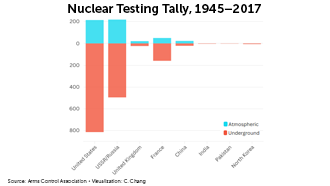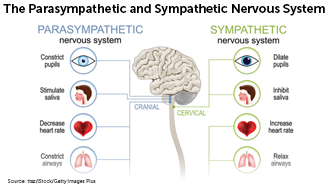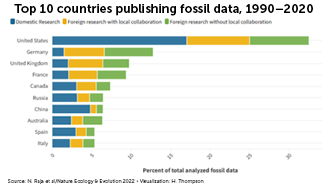Search Results

Nuclear testing tally
Beginning with the first test explosion in 1945, more than 2,000 atomic blasts have rattled the globe. Nuclear testing dwindled after a treaty in the 1990s. Recently, some in the United States have called for resumed testing, which could have serious consequences for the environment and global politics.

Dino Tracks and Chemical Predation
Use news articles from the September Science News issue to discuss the challenges of relying on a tidy math equation to predict the speed of dinosaurs and learn the chemical predation tactics of the feather-legged lace weaver spider before researching other organisms that use chemical means for predation.
The art of chemical predation
Predation occurs when one organism, the predator, kills and eats another organism, its prey. In this lesson, students will learn about the recently discovered chemical predation tactics of the feather-legged lace weaver spider, which vomits toxins on its prey. Students will explore the possible evolutionary advantages and disadvantages of this technique and research another organism that uses chemical means for predation.
Tracking dinos
T. rex or Velociraptor — who would win in a race? Scientists of the 1970s developed a set of equations that led modern scientists to predict speed of dinosaurs. But how well do those equations predict real life? Learn how a tidy math equation can sometimes oversimplify complex issues. Answer questions about how missing variables might lead to flawed conclusions and discuss challenges from inferring the behavior and characteristics of long-extinct species from available evidence.

Agriculture may be growing ozone
The air pollutant ozone has been linked to health problems including respiratory illness, reproductive problems and some cancers. Levels of ozone in the United States have come down over time but have started to rise again in places because of wildfires and soil emissions.

Got stress?
The sympathetic nervous system — our fight-or-flight response — kicks in when we face a big challenge or risk. When we’re relaxed, our parasympathetic nervous system takes over. Together these two systems make up the autonomic nervous system.

All About Analyze This, KWL and How to Hula Hoop
Use these lesson plans paired to articles from the June/July issue of Science News Explores to have students analyze data visualizations from Analyze This articles, get a template to use the KWL literacy practice with your students and learn how to hula hoop using physics principles.
Hula-hooping robots
Scientists built hula-hooping robots to answer an old mystery: How does a Hula Hoop stay up? Learn how best to launch and maintain a circulating hoop — and then explore how specific shapes can turn gyrations into a gravity-defying force. You can apply those concepts to then predict the hula-hooping success of other shapes.
All about Analyze This: An article type from Science News Explores
Use this lesson plan to learn about an article type called Analyze This that is published by Science News Explores in print and online. You can also access a lesson plan template that can be used with any Analyze This article. Each Analyze This article includes a graph or data visualization that is paired with questions for students to answer and a short story that provides context.
Literacy Practice: KWL Strategy
Use this lesson plan and the provided template to have your students practice the KWL strategy. This note-taking strategy helps students organize their thoughts and reflect on their knowledge around a particular reading.

Renewable power is a bright idea
Over the past two decades, electricity from renewable sources, such as wind and solar, has been on the rise. Devices known as grid-forming inverters will likely play a major role in getting renewable energy safely into the power grid.

Parachute paleontology
Fossil research has been plagued by parachute paleontology. This happens when scientists from high-income countries travel to low-income countries to study or collect fossils but don’t involve local experts. Sometimes foreign scientists skirt local laws about exporting fossils or buy them under sketchy or even illegal circumstances.